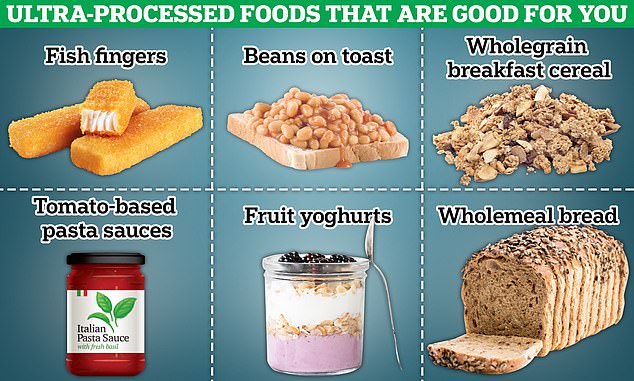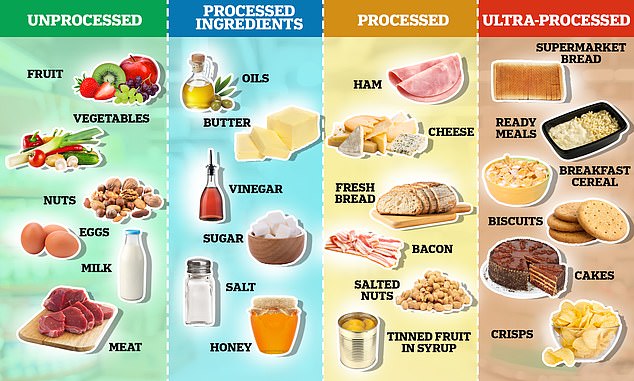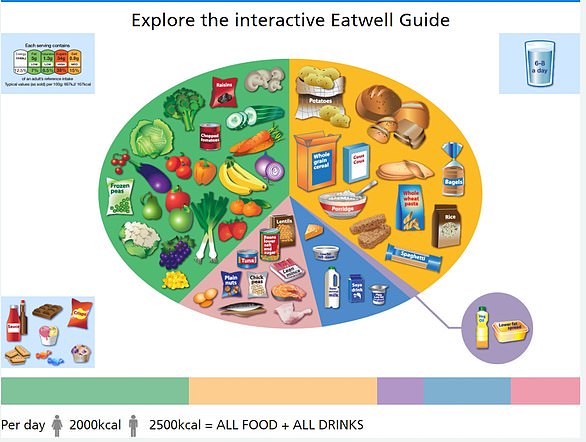They have become a staple of the modern British diet, stacked on the shelves of our supermarkets, in our kitchen cupboards and in the refrigerators of our homes.
However, ultra-processed foods (UPF) may be sending us to an early grave.
Numerous studies have found links between soda, cookies and convenience foods and a catalog of health problems, including heart disease and even some cancers.
But UPFs can also have effects on everyday life, like making your hair greasy.
A fascinating graph from MailOnline demonstrates exactly what they could be doing to your hair, skin and brain.
It comes as researchers at Harvard University found that people who consume more UPF have a marginally higher risk of premature death.
The experts based their findings on a study of 115,000 healthy American adults who had their health and diet tracked over 30 years of life.
The researchers found a 4 percent increase in people who ate about seven servings of junk food a day, compared to people in the study who ate half that amount.
While the increased risk was only statistically small, the team argued that their findings echoed calls to limit certain types of UPF.
UPF is a general term used to cover anything edible made with dyes, sweeteners, and preservatives that extend shelf life.
The Nova system, developed by scientists in Brazil more than a decade ago, divides foods into four groups based on the amount of processing they have gone through. Unprocessed foods include fruits, vegetables, nuts, eggs, and meat. Processed culinary ingredients, which are not typically eaten alone, include oils, butter, sugar, and salt.
Prepared meals, ice cream, and tomato ketchup are some of the most beloved examples of products that fall under the umbrella term UPF, now synonymous with foods that offer little nutritional value.
They are different from processed foods, which are modified to make them last longer or improve their flavor, such as cured meat, cheese, and fresh bread.
However, dietitians argue that this blanket judgment wrongly singles out “healthy” options like fish fingers and baked beans.
The new paper adds to growing evidence illustrating the health risks of UPFs, which have been vilified for decades for their observed links to cancer and dementia.
During the 34-year follow-up period, researchers recorded 48,193 deaths, including more than 13,000 due to cancer and just over 11,000 attributed to cardiovascular disease.
However, no specific relationship was observed between total UPF consumption and deaths from cancer or heart disease.
In contrast, the elevated risk (amounting to 64 additional deaths per 100,000 person-years) was only observed in deaths from all causes.
They also found There is no relationship between premature death and condiments, sauces and salty snacks.
Even with sugary drinks and convenience foods, the risk was less pronounced after the researchers took into account the overall quality of the diet of the participants, who were asked about their eating habits every four years.
The risk was up to 13 percent for some UPFs.
writing in the British medical journalThe scientists said: “The findings support the need to limit consumption of certain types of ultra-processed foods for long-term health.”
But today experts criticized the investigation.
Sir David Spiegelhalter, emeritus professor of statistics at the University of Cambridge, said: “This study shows weak associations between ultra-processed foods and overall mortality.”
Dietitian Dr Duane Mellor, spokesperson for the British Dietetic Association, said: “It is also notable that those who ate the most ultra-processed foods tended to eat few vegetables, fruits, legumes and whole grains.
“It may not be as simple as saying that those who eat more ultra-processed foods are more likely to die earlier; it is quite possible that these foods could displace healthier foods in the diet.”
He added: “Not all UPF groups are associated with the same health risks, with sugar, artificially sweetened beverages and processed meats being most clearly associated with the risk of premature death.”
Professor Gunter Kuhnle, an expert in nutrition and food science at the University of Reading, said it was “impossible to know how reliable the results are” because of the way the study was carried out.
He said: “The results should therefore be treated with great caution.”
‘I don’t think this study provides evidence to suggest limiting certain foods just because of their level of processing.

Food experts say some UPF can be “part of a healthy diet.” Baked beans, fish fingers and whole wheat bread are sufficient, according to the British Nutrition Foundation (BNF). Tomato-based pasta sauces, whole grain breakfast cereals and fruit yoghurts are also “healthier processed foods”, the charity claims.
‘Public health policies should be evidence-based, and there is very good evidence on the health effects of foods based on their composition, which is largely confirmed by this study.
“In contrast, there is still virtually no solid evidence that ‘ultraprocessing’ has any specific effect on health.”
The UK is the worst country in Europe for UPF consumption, which makes up around 57 per cent of the national diet.
They are believed to be a key driver of obesity, which costs the NHS around £6.5 billion a year.
They often contain colorings, emulsifiers, flavorings and other additives, and typically undergo multiple industrial processes that research shows break down the physical structure of foods, making them faster to absorb.
This, in turn, increases blood sugar, reduces satiety, and damages the microbiome, the community of “friendly” bacteria that live inside us and that we depend on for good health.



